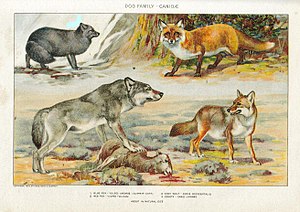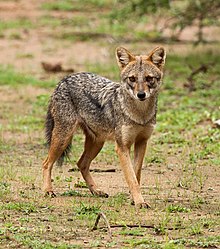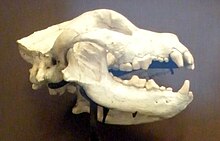dogs
| dogs | ||||||||||||
|---|---|---|---|---|---|---|---|---|---|---|---|---|

Arctic fox ( Vulpes lagopus ) • Red fox ( Vulpes vulpes ) • Mackenzie wolf ( Canis lupus occidentalis ) • Coyote ( Canis latrans ) |
||||||||||||
| Systematics | ||||||||||||
|
||||||||||||
| Scientific name | ||||||||||||
| Canidae | ||||||||||||
| G. Fischer de Waldheim , 1817 | ||||||||||||
| Tribe | ||||||||||||
|
The dogs (Canidae) are a family within the superfamily of the canine species (Canoidea). The dogs include, for example, the foxes , various species known as “ jackals ”, coyotes and wolves , their domesticated forms, the domestic dogs , which gave the group its name.
features
The Canidae have four complete toes on the hind feet and four ( Lycaon ) or five ( Canis , Cyon , Otocyon , Speothos ) on the front feet, whereby the first toe of the front feet is not functional (weight-bearing). All canids are toe walkers , which means that they only touch the anatomical toes when they run, not the entire anatomical foot.
The teeth of canines usually has 42 teeth on. On each side there are three incisors (incisors), a canine (fangs) and four premolars ( premolars ) as well as two molars (molars) above and three molars below. The tooth formula for the complete set of teeth is therefore:
| 3 x 1 x 4 x 2 |
| 3 x 1 x 4 x 3 |
The formula for the first generation of teeth ("deciduous teeth") is: 3 · 1 · 3 · 0, that is, canids have no molars when they are young and only three premolars in each quarter of the teeth.
distribution
Canidae are represented on all continents . Originally, they were absent in Australia , New Guinea , New Zealand , Madagascar and Antarctica , but in many of these regions they were introduced by humans , mostly in the form of domestic dogs . In Australia there is even a secondary feral form of the domestic dog, the dingo .
behavior
Generally valid statements about the behavior of canids can hardly be made because the individual genera and species differ too much. For example, all canids are carnivores by definition and therefore all show hunting and killing behavior , but this already differs considerably between wolves and domestic dogs .
The different behavior patterns in wolves and foxes, for example, are already evident between the fourth and fifth week of life. Erik Zimen observed in puppies that foxes first pick up the chunks of food when they are being fed, bury them in the area and only then start eating; young wolves, on the other hand, devour as much food as possible and only then begin to bury leftover food.
Michael W. Fox describes the initiation of social encounters by mutual examination of the genital and anal zone and, in some cases, of the ears, mouth and anal gland as a generally similar behavior pattern in all canids . The smelling of the tail gland region was mainly observed in red, arctic and gray foxes, but less often in prairie wolves and practically not at all in domestic dogs, since the tail gland is rarely present in these dogs.
Sometimes behavior patterns are also recognized between species. For example, Fox describes a successful request to play a Chihuahua by a prairie wolf , mutual submission between young coyotes and wolves, and game sequences between an adult wolf and a red fox .
development
According to Matthew, Colbert and others, the Canidae can be traced back to Miacis , a "small, crawling, carnivorous mammal" that lived between the Eocene and the Oligocene (about 40 million years ago). Two basic forms emerged from Miacis in North America , Daphaenus (also: Daphoenus ) and Cynodictis (also: Hesperocyon ). The bears (Ursidae) developed from the former, the "ancestors" of today's dogs from the latter.
Temnocyon , an ancestor of the African hyena dogs and the Asian red dogs, and Cynodesmus split off from the Hesperocyon or Cynodictis ; this in turn is an ancestor of Tomarctus , which is the direct ancestor of wolf ( Canis lupus ), foxes ( Vulpes ) and some others such as Borophagus , Aelurodon and probably also Otocyon .
Systematics
Today's types of dogs
Classic taxonomy
The on phenotypic ( morphological ) differences based traditional classification divides the recent dog into two tribes , which the genuine foxes (Vulpini) and the Real dogs (canine). However, within real dogs there are also many species that look like a fox .





- Tribe Vulpini
- Genus Vulpes
- Bengal fox ( Vulpes bengalensis )
- Afghan fox ( Vulpes cana )
- Cape fox ( Vulpes chama )
- Steppe fox ( Vulpes corsac )
- Tibetan fox ( Vulpes ferrilata )
- Arctic fox ( vulpes lagopus )
- Kit fox ( Vulpes macrotis )
- Pale fox ( Vulpes pallida )
- Rüppellfuchs ( Vulpes rueppelli )
- Swift fox ( Vulpes velox )
- Red fox ( Vulpes vulpes )
- Fennec ( Vulpes zerda )
- Genus Urocyon
- Gray fox ( Urocyon argenteus )
- Island gray fox ( Urocyon littoralis )
- Genus Otocyon
- Scoop dog ( Otocyon megalotis )
- Genus Vulpes
- Canini tribe Dusicyon australis )
- Andean jackal ( Lycalopex culpaeus )
- Darwin fox ( Lycalopex fulvipes )
- Argentine fox ( Lycalopex griseus )
- Pampas fox ( Lycalopex gymnocercus )
- Sechurafuchs ( Lycalopex Sechurae )
- Brazilian fighting fox ( Lycalopex vetulus )
- Short- eared fox ( Atelocyon microtis )
- Maikong ( Cerdocyon thous )
- Forest dog ( Speothos venaticus )
- Maned Wolf ( Chrysocyon brachyurus )
- Raccoon dog ( Nyctereutes procyonoides )
- Red dog ( Cuon alpinus )
- African wild dog ( Lycaon pictus )
- Striped Jackal ( Canis adustus )
- African gold wolf ( Canis anthus )
- Golden jackal ( Canis aureus )
- Coyote ( Canis latrans )
- Wolf ( Canis lupus ), including domestic dog and dingo
- Black-backed jackal ( Canis mesomelas )
- Red wolf ( Canis rufus )
- Ethiopian wolf ( Canis simensis )
Taxonomy on a molecular genetic basis
Modern methods for determining the relationship and the mutual evolutionary relationships of the organisms are based not only on more objective methods of characteristic analysis (see → cladistics ) but also on the comparison of genes or DNA sequences at the molecular level. In 2005, Lindblad-Toh et al. (2005) proposed a kinship hypothesis of the canids, which was created with the methods of cladistics on the basis of such molecular genetic data. In this approximately 15 kilobases of exon - and intron - sequences compared.
This hypothesis had some fundamental consequences with regard to the classical system:
- The most noticeable difference is that in the canids, not two, but three or four main lines of development (represented by the tribe or subtribe, in the cladogram by corresponding main clades ) can be recognized, which also show a completely different evolutionary history: the classic Tribe Vulpini is divided into the clade of the gray foxes and the clade of the red fox-like, whereby the clade of the red fox-like is more closely related to the other two clades (classical tribe Canini) than to the gray foxes. The Canini tribe is divided into a South American clade and the wolf-like clade, which have a sister group relationship with one another. This means that the gray fox line did not separate itself directly from the red fox line, as reflected in the classic system, but much earlier, even before the separation of the red fox and wolf lines.
- The raccoon dog ( Nyctereutes procyonoides ), previously placed with the Canini, is now part of the "Vulpini" or in the clade of the red fox-like.
- The Canis genus can no longer be maintained as it has been seen by the majority of classical systematists. Gray wolf, coyote, golden jackal and Ethiopian wolf (all genus Canis ) are more closely related to the red dog (genus Cuon ) and the African wild dog (genus Lycaon ) than to the striped and black-backed jackal (both so far also genus Canis ). If this is confirmed in future analyzes, then
- Red and wild dogs are included in the genus Canis or
- for striped and black-backed jackal either, as some systematists have been practicing for around 100 years due to morphological characteristics, the genus Thos Oken , reactivated in 1816 or, following Zrzavý and Řičánková (2004), the monotypical genera Schaeffia Hilzheimer , 1906 and Lupullella Hilzheimer , 1906 (with the species Schaeffia adusta or Lupulella mesomelas ) are "revived".
| Phylogeny of dogs according to Lindblad-Toh et al. (2005) | |||||||||||||||||||||||||||||||||||||||||||||||||||||||||||||||||||||||||||||||||||||||||||||||||||||||||||||||||||||||||||||||||||||||||||||||||||||||||||||||||||||||||||||||||||||
|---|---|---|---|---|---|---|---|---|---|---|---|---|---|---|---|---|---|---|---|---|---|---|---|---|---|---|---|---|---|---|---|---|---|---|---|---|---|---|---|---|---|---|---|---|---|---|---|---|---|---|---|---|---|---|---|---|---|---|---|---|---|---|---|---|---|---|---|---|---|---|---|---|---|---|---|---|---|---|---|---|---|---|---|---|---|---|---|---|---|---|---|---|---|---|---|---|---|---|---|---|---|---|---|---|---|---|---|---|---|---|---|---|---|---|---|---|---|---|---|---|---|---|---|---|---|---|---|---|---|---|---|---|---|---|---|---|---|---|---|---|---|---|---|---|---|---|---|---|---|---|---|---|---|---|---|---|---|---|---|---|---|---|---|---|---|---|---|---|---|---|---|---|---|---|---|---|---|---|---|---|---|
|
Legend: |
||||||||||||||||||||||||||||||||||||||||||||||||||||||||||||||||||||||||||||||||||||||||||||||||||||||||||||||||||||||||||||||||||||||||||||||||||||||||||||||||||||||||||||||||||||
Nyakatura and Bininda-Emonds (2012) achieved slightly different results for the canids in a detailed “supertree” / “supermatrix” analysis of the relationships of all predators, which in addition to the cladogram structures of previous analyzes also included around 45,000 base pairs from the GenBank database . With them the African wild dog ( Lycaon pictus ) is not in the wolf clade, but is the sister species of the South American forest dog ( Speothos venaticus ) and both form the sister group of the common clade of wolf clade and South American clade. Accordingly, there are three different main lines within the classic Canini. In a separately carried out “supermatrix” analysis, which was based only on the DNA data, the results deviated even more. a. in that the genus Vulpes appears as a paraphyletic grouping at the base of a common clade from Canis and some South American representatives. However, the “supertree” and “supermatrix” methods are controversial as they are based on incoherent data sets.
| Simplified cladogram according to Nyakatura and Bininda-Emonds | |||||||||||||||||||||||||||||||||||||||||||||||||||||||||||||||||||||||||||||||||||||||
|---|---|---|---|---|---|---|---|---|---|---|---|---|---|---|---|---|---|---|---|---|---|---|---|---|---|---|---|---|---|---|---|---|---|---|---|---|---|---|---|---|---|---|---|---|---|---|---|---|---|---|---|---|---|---|---|---|---|---|---|---|---|---|---|---|---|---|---|---|---|---|---|---|---|---|---|---|---|---|---|---|---|---|---|---|---|---|---|
|
Fossil dogs
In addition to the 34 still living species of dogs, a total of around 180 fossil dog species are known today. With new discoveries, this number continues to rise. In vertebrate paleontology, the Canidae family is divided into three subfamilies: the Caninae , to which all current ( recent ) dog species belong (accordingly, plus fossil representatives, identical in content to the Canidae family in the recent zoological sense, see above ), and the extinct subfamilies Borophaginae and Hesperocyoninae . The Caninae also represent the geologically youngest fossil dogs that only disappeared around 10,000 years ago at the end of the Pleistocene, such as the American forms Canis dirus and Protocyon .
The classification of the Hesperocyoninae follows Wang (1994), that of the Borophaginae Wang et al. (1999) ( Mya = million years ago).
- Unterfam. Borophaginae †
- Genus Aelurodon (16–12 Mya)
- Genus Archaeocyon (32 Mya)
- Genus Borophagus (12-5 Mya)
- Genus Cynarctoides (30–18 Mya)
- Genus Cynarctus (16-12 Mya)
- Genus Desmocyon (24–19 Mya)
- Genus Epicyon (12-10 Mya)
- Genus Eulopocyon (18-16 Mya)
- Genus Metatomarctus (19-16 Mya)
- Genus Microtomarctus (18 Mya)
- Genus Osteoborus (8 Mya)
- Genus Otarocyon (34–30 Mya)
- Genus Oxetocyon (32 Mya)
- Genus Paracynarctus (19-16 Mya)
- Genus Phlaocyon (30–19 Mya)
- Genus Protepicyon (16 Mya)
- Genus Psalidocyon (16 Mya)
- Genus Rhizocyon (30 Mya)
- Genus Tephrocyon (16 Mya)
- Genus Paratomarctus (16-13 Mya)
- Genus Protomarctus (18 Mya)
- Genus Tomarctus (16 Mya)
- Unterfam. Hesperocyoninae †
- Genus Cynodesmus (32–29 Mya)
- Genus Caedocyon ?
- Genus Ectopocynus (32–19 Mya)
- Genus Enhydrocyon (29-25 Mya)
- Genus Hesperocyon (37–34 Mya)
- Genus Mesocyon (34–29 Mya)
- Genus Osbornodon (32–18 Mya)
- Genus Paraenhydrodon (30-25 Mya)
- Genus Philotrox (29 Mya)
- Genus Prohespercyon (36 Mya)
- Genus Sunkahetanka (29 Mya)
- Unterfam. Caninae
Individual evidence
- ↑ See St. G. Mivart: Monograph of the canidae . London: RH Porter and Dulan, 1890, cit. in: Fox 1975
- ↑ See, for example, Zimen 2003: pp. 47–49 (section Differences between wolf and dog ).
- ↑ Zimen 2003: pp. 40–42 (section Differences in Wolf and Fuchs ).
- ↑ Fox 1975: p. 66 f.
- ↑ Fox 1975: p. 148 ff. (Section Inter-species connections in canids )
- ^ WD Matthew: " The phylogeny of dogs ", in: Journal of Mammlogy 11/1930, pp. 117-138; EH Colbert: " Origin of the Dog ", in: Natural History , 43/1939, pp. 90-101
- ↑ a b Kerstin Lindblad-Toh et al .: "Resolving canid phylogeny." Section in: Kerstin Lindblad-Toh et al .: Genome sequence, comparative analysis and haplotype structure of the domestic dog. Nature 438, December 2005; Pp. 803-819.
- ↑ Eberhard Trumler : My wild friends. The wild dog species in the world. Munich, Piper Verlag, 1981. ISBN 3-492-02483-1 . P. 68 f. - For an overview of the Thos / Canis debates see: Holger Homann: Thos vs. Canis. ( Memento from November 13, 2014 in the Internet Archive ) Holger Homann's Home Page (holgerhomann.us, private cynological website), 2004 (English).
- ↑ Jan Zrzavý, Věra Řičánková: Phylogeny of Recent Canidae (Mammalia, Carnivora): Relative Reliability and Utility of Morphological and Molecular Datasets , in: Zoologica Scripta Volume 33, No. 4, July 2004, pp. 311–333, doi: 10.1111 /j.0300-3256.2004.00152.x .
- ↑ a b c Katrin Nyakatura, Olaf RP Bininda-Emonds: Updating the evolutionary history of Carnivora (Mammalia): a new species-level supertree complete with divergence time estimates. BMC Biology 10, 2012. doi: 10.1186 / 1741-7007-10-12
- ↑ Xiaoming Wang, Richard H. Tedford, Mauricio Antón: Dogs, their fossil relative & evolutionary history. Columbia University Press, New York, 2008. ISBN 978-0-231-13528-3 , Appendix 1 (p. 169 ff.), Appendix 2 (p. 177 f.)
- ↑ a b Xiaming Wang: Phylogenetic Systematics of the Hesperocyoninae (Carnivora: Canidae). Bulletin of the American Museum of Natural History No. 221, Sept. 15, 1994 (New York). ISSN 0003-0090 - Phylogenetic Analysis of Hesperocyoninae Finds from the Frick Collection at the American Museum of Natural History, New York.
- ↑ a b Xiamind Wang, RH Tedford, BE Taylor: Phylogenetic systematics of the Borophaginae (Carnivora: Canidae). Bulletin of the American Museum of Natural History No. 243, 1999, pp. 1-391.
literature
- Michael W. Fox: From Wolf to Dog . Development, behavior and social organization. Munich: BLV 1975. ISBN 3-405-11365-2 - standard work on dogs / canids; engl. Original edition: Behavior of Wolfes, Dogs and Related Canids .
- Jean-Olivier Gransard-Desmond: Ètude sur les Canidae des temps pré-pharaoniques en Ègypte et au Soudan . BAR International Series 1260. Oxford: Archaeopress 2004. ISBN 1-84171-618-9 - Archaeological study of the origins of dogs in ancient Egypt and Sudan, with descriptions of numerous prehistoric finds and a catalog of important excavation sites.
- Erik Zimen : The wolf . Stuttgart: Kosmos 2003. ISBN 3-440-09742-0 .
Web links
- Dogs (Canidae): Mammals ( Memento of March 24, 2012 in the Internet Archive ) ( Information Center Chemistry Biology Pharmacy of the ETH Zurich) - extensive link collection
- Canid Specialist Group of the International Union for the Conservation of Nature (IUCN)
- Canids: Foxes, Wolves, Jackals and Dogs - 2004 Status Survey and Conservation Action Plan ( Memento of December 8, 2013 in the Internet Archive ) Canid Specialist Group of the IUCN







